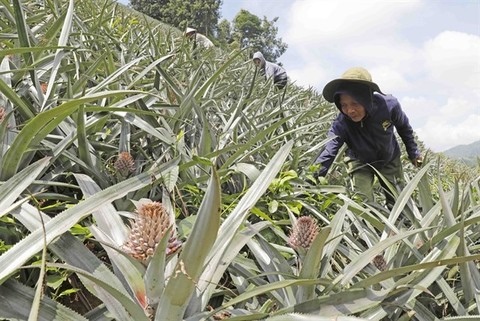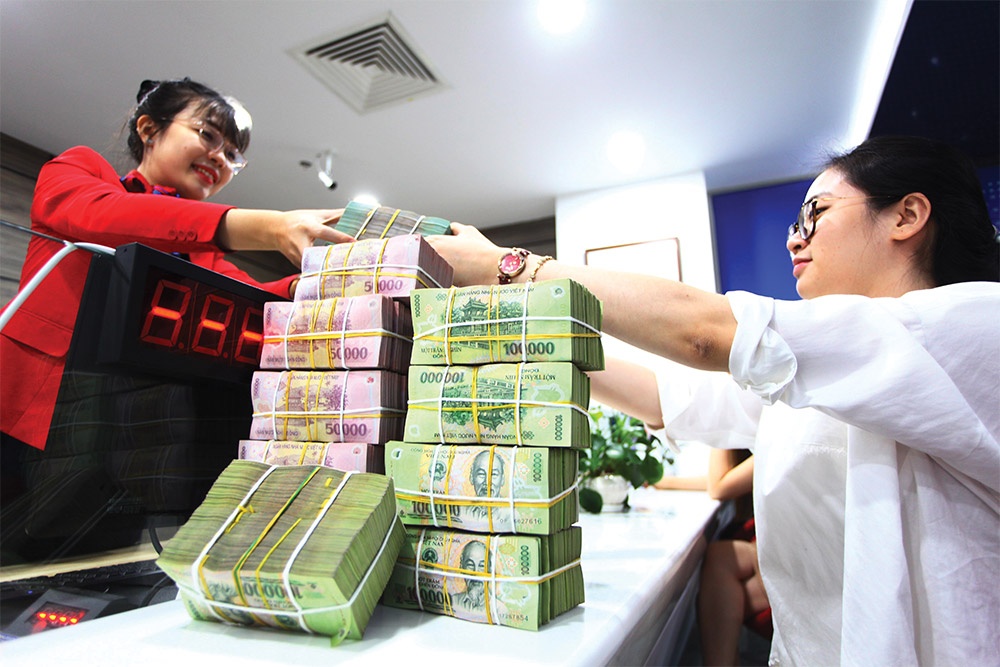Central bank confident about credit growth this year
Central bank confident about credit growth this year
The State Bank of Việt Nam is confident about reaching this year's credit growth target, as lending is expected to accelerate in the remaining months of the year on the recovery of production and business, Deputy Governor of the State Bank of Việt Nam (SBV) Đào Minh Tú has said.

A farmer in Lào Cai Province borrows money from bank to plant pineapples. Credit has quickened recently to reach 8.53 per cent as of September 21, making the credit growth target of 15 per cent achievable. — VNA/VNS Photo Trần Việt |
“There are positive signs recently. The credit growth target of around 15 per cent is achievable,” Tú said.
The latest updates from the General Statistics Office show that credit has expanded to 8.53 per cent as of September 21, compared to 6.24 per cent at the same time last year. The total means of payment increased by 5.1 per cent, while capital mobilisation of credit institutions rose by 4.79 per cent.
SBV’s statistics also show that credit previously rose by 7.26 per cent over the end of 2023.
These figures demonstrate that credit increased rapidly in the last two weeks of September, and is forecast to rise still further in the remaining months of this year.
Credit institutions have pumped an estimated VNĐ1.1 quadrillion (US$44.2 billion) into the economy so far this year.
Since the end of the second quarter, the SBV has asked credit institutions to make an effort to reduce lending interest rates. The average lending interest rate saw a strong decrease by more than one percentage point per year in August over the end of 2023, to around 6.8 to 9.2 per cent per year for both new and existing loans in Vietnamese đồng.
The SBV has also allowed credit institutions that have used up to 80 per cent of their allocated credit growth quotas to automatically increase their outstanding credit based on their ratings.
As for social policy credit, a total sum of VNĐ90.2 trillion has been disbursed as of the end of September to more than 1.8 million poor and near-poor households and other beneficiaries.
According to General Director of Sacombank Nguyễn Đức Thạch, to accelerate credit growth, it is necessary to maintain the expansionary fiscal policy to boost aggregate demand and stimulate economic recovery. Tax and fee reductions will support consumption and purchasing power.
Vietcombank Securities Company recently forecast that the demand for credit will accelerate in the second half of this year, as the rates are kept at low levels. Major drivers for credit growth will come from real estate, production, public investment, retail and lending to support production and business after Typhoon Yagi.
The SBV said a combination with other macro-economic policies is needed to improve the capital absorption capacity of enterprises.
However, Nguyễn Quốc Hùng, general secretary of the Việt Nam Banks Association, urged caution regarding bad debts, which are at risk of rising in a period of loosening monetary policy.
To achieve the credit growth target of 15 per cent, an average sum of VNĐ227 trillion must be pumped into the economy per month from now until the end of the year, nearly double the figure from the first months of this year.
Lê Duy Nhân from the Vietcombank Fund Management also said that consumer price index (CPI) is forecast to be below 4 per cent this year, providing room for the SBV to continue its expansionary monetary policy.
There are signs deposit interest rates are bottoming out and are under pressure to increase due to rising credit demand, but the increases are not expected to be too significant, he said, adding that the environment of low interest rates is favourable for consumption and investment. However, a close watch must be kept on bad debts.
Speed up disbursement
It is necessary to speed up the disbursement of preferential credit packages to accelerate the recovery of production and business.
Currently, several preferential credit packages are being implemented, such as the VNĐ140 trillion social housing package for low-income earners and workers, the VNĐ60 trillion package for the forestry-fishery sector and the VNĐ405 trillion package for enterprises and citizens affected by Typhoon Yagi.
Some packages are seeing good disbursement, while some are stagnant.
For example, only VNĐ1.34 trillion has been disbursed from the VNĐ140 trillion social housing package as of June, due to limited social housing supply and hesitance over rates and preferential terms.
Meanwhile, a package for the forestry and fishery sector saw good disbursement. As of mid-September, the disbursement reached VNĐ36 trillion, VNĐ6 trillion higher than the quota of VNĐ30 trillion set in February. The entire package has been increased to VNĐ60 trillion after the typhoon wreaked havoc in the northern region and heavily affected the fishery sector.
Speeding up lending to typhoon-hit enterprises is also vital to support them in overcoming difficult times, according to the Việt Nam Chamber of Commerce and Industry.
To date, 32 out of 40 commercial banks registered new preferential credit packages worth up to VNĐ405 trillion, with rates of 0.5 to 2 percentage points lower than commercial interest rates to support enterprises and residents affected by Typhoon Yagi.
The connection between banks and enterprises is effective in increasing disbursement of the preferential credit packages.
In HCM City, for example, disbursed capital from a preferential credit package through a programme connecting banks and enterprises reached VNĐ425.659 trillion, or 84.3 per cent, according to the SBV’s branch in HCM City.
It is also necessary to effectively speed up the disbursement of preferential credit packages through removing bottlenecks in procedures and improving transparency so that enterprises and residents can access credit easily.
The Government recently asked the SBV and relevant ministries to develop a VNĐ30 trillion package for the Việt Nam Bank for Social Policies to provide preferential loans for home purchases, construction and repairs in October.


























